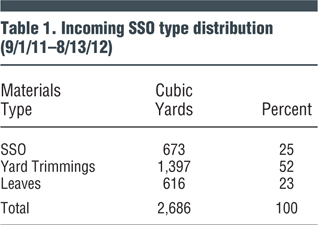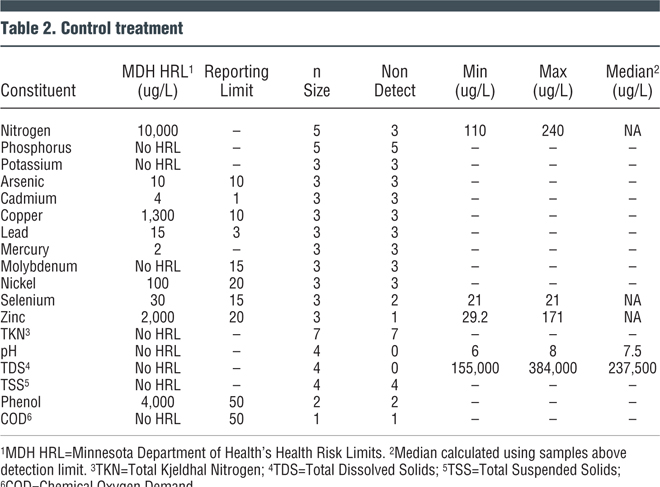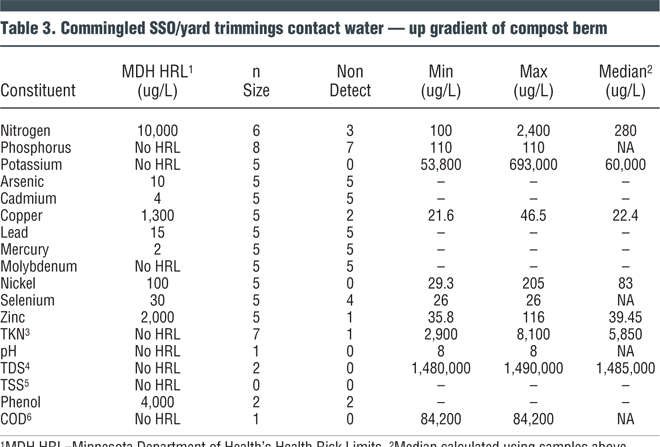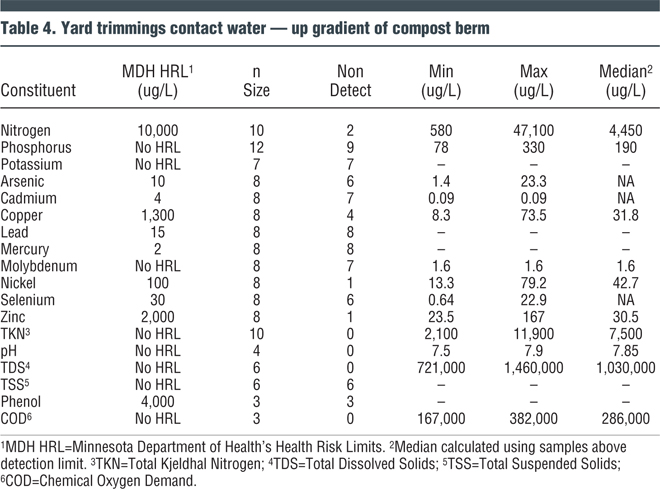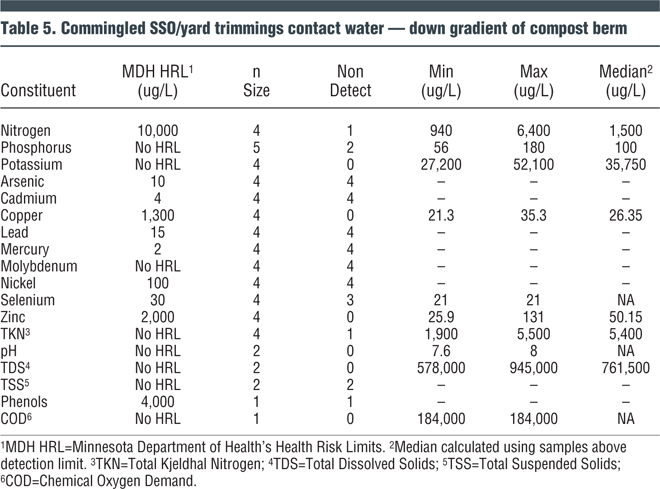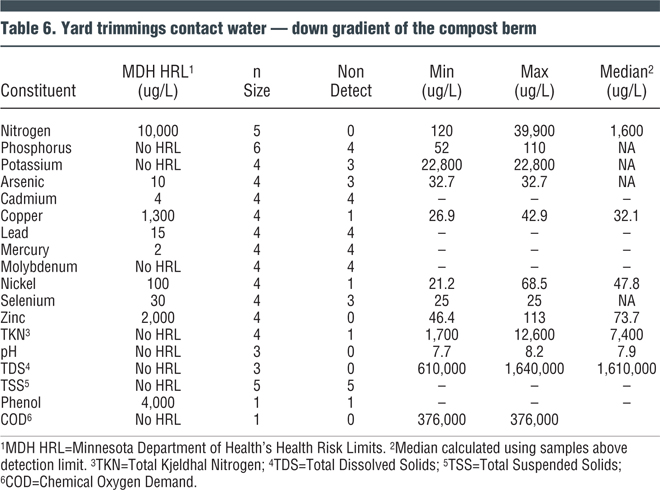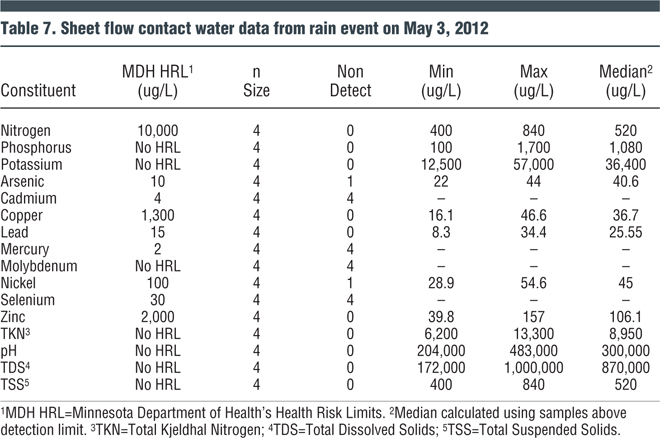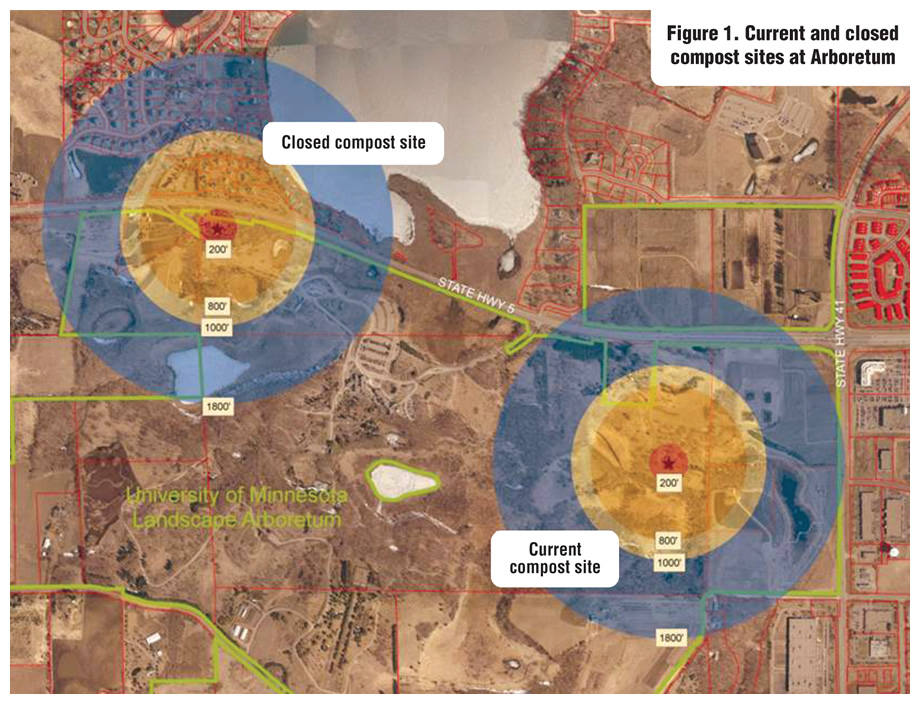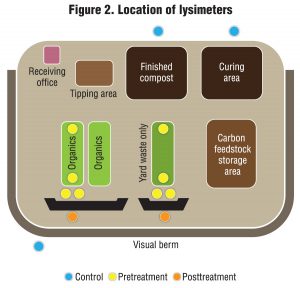Research study analyzed ground water coming into contact with active composting piles — both yard trimmings only and yard trimmings with food waste and paper. Part II
Ginny Black and Marcus Zbinden
BioCycle September 2014
This article series on potential environmental impacts of composting is focusing on water quality and the addition of source separated organics to yard trimmings composting sites. It is based on research conducted at the University of Minnesota Landscape Arboretum in Chanhassen, Minnesota by Carver County Environmental Services.
In August of 2010, Carver County’s Division of Environmental Services received a $100,000 grant from the Minnesota Pollution Control Agency (MPCA). The project had three primary goals: 1) Establish a new source separated organics composting site at the University of Minnesota Landscape Arboretum in Chanhassen; 2) Demonstrate, by establishing best management practices (BMPs), that the site can effectively compost organics; and 3) Provide MPCA with additional data regarding contact water to assist the Agency with a parallel compost rule revision process.
With support from the MPCA grant, the Arboretum was able to relocate its source separated organics composting site to a new location to alleviate odor issues that impacted homes located within 250 feet from the previous site. The new site had a buffer greater than 1,800 feet from the nearest neighboring residential or commercial properties. It is surrounded by trees and visible only by visitors to the Arboretum who walk on a trail near the site (Figure 1). The Arboretum contracted with Specialized Environmental Technologies (SET) to operate the new site.
A Demonstration Research Project permit was secured from the MPCA. It specified an annual capacity of 13,000 cubic yards (cy) (down from 20,000 cy at any one time permitted at the first site). In addition, a limit of 20 percent of the 13,000 cy was set for source separated organics (SSO), including food waste and nonrecyclable paper. The remaining quantity is yard trimmings. The percentage was based on volumes received during the calendar year.
This article builds on the research findings reported in Part I of this series, “Adding SSO To Yard Trimmings Composting Operations” (July 2014).
Site Construction
Construction of the new 2-acre site mirrored the specifications being considered as a revision to the Minnesota Compost rules for a SSO composting facility. At that time, the proposed rules allowed for construction of a SSO composting facility on any combination of the following nine soil types: sandy clay loam, sandy clay, clay loam, silty clay loam, silty clay, clay, loam, silty loam and silt. The proposed rules also included a 5-foot separation distance to the water table. If those conditions were met the facility could operate on an all-weather drivable surface.
The soils on the site are a loam, sloped to the southwest and with a 3 percent grade that follows the natural contour. In addition, a 6-inch pad consisting of a base compacted Class V aggregate covered the entire operating surface. The U. S. Geological Survey records the water table to be 78 inches below the surface. Finally, a berm, seeded with fescue grass and oats, was constructed as a visual screen from patrons using a nearby Arboretum hiking trail.
The new operator switched to a static aerated windrow system, defined in the proposed revised rule as a mechanical aeration system inserted at the base of a long row of organic material with a limited height. This eliminated the need to turn the windrows, minimizing the release of odors. In addition, lysimeters were installed to continue the research regarding the chemistry of contact water infiltrating into subsoils below the pad.
Operational History
Acceptable materials remained the same as the initial project, which included food waste and nonrecyclable paper. However, the arrival of Emerald Ash Borer to the Minneapolis Metro Area drastically reduced the amount of SSO cocollected with yard trimmings that was delivered to the facility during the quarantined time period — April 1 to September 30 every year. As a result, SET, the site operator, had to truck in yard trimmings from another site in order to have enough carbon available to mix with the source separated organics.
A total of 2,686 cy of organics were delivered to the facility in the first year of operation (Table 1). The percent of organics delivered to the site was based on a series of waste sorts. Acceptable contamination levels for each load were set at 10 percent or less. Loads delivered to the site were visually inspected by the operator and the driver. If the level of contamination was deemed to be greater than 10 percent, the hauler had to remove the material.
Just prior to this project, a law was passed mandating that residents who bag yard trimmings must use compostable bags for collection in the Twin Cities of Minneapolis-St. Paul and the seven counties that make up Minnesota’s main metropolitan area. If the bags were plastic, they had to be certified compostable, meeting the ASTM D6400 test requirements and displaying the Biodegradable Products Institute logo. This drastically reduced contamination in the finished product and increased the sale price of the compost. Loads delivered to the facility had minimal contamination and no loads were rejected.
With the switch to aerated static windrows, odors were drastically reduced and no odor complaints were received from neighbors. Initially, SET used a windrow turner to debag the incoming materials. This method dispersed paper items around the site, thus increasing the need for clean up. A Supreme mixer was later purchased and used to debag/mix the source separated organic materials and yard trimmings prior to placement in windrows. This change resulted in two benefits — the litter problem was drastically reduced and a more homogenous mix of SSO and yard trimmings was placed in the windrows.
Project Design
The primary goal of the project was to determine potential environmental impacts from contact water generated at a source separated organics composting site. As a result of unanswered questions from the initial research described in Part I of this article series, changes were made to the sampling procedure. First, lysimeters were installed outside of the composting area as controls to obtain base level readings from natural rainfall infiltrating the native soils. Second, since the vast majority of contact water does not infiltrate through the compost pad and into subsoils, but rather flows off the site as storm water, the MPCA added sheet flow sampling to the testing protocol. Finally, sampling for phenols and COD (chemical oxygen demand) were added to the testing protocol.
The location and installation of the lysimeters was overseen by Professor Thomas Halbach of the University of Minnesota’s Department of Soil, Water and Climate. The lysimeters were buried at a depth of 36 inches and placed under negative pressure to allow for collection of contact water that infiltrated into the subsoils. Figure 2 shows the location of the lysimeters. For comparison purposes, two lysimeters were installed under the SSO windrow and two under the yard trimmings only windrow. Four lysimeters were installed, two each, down slope of each windrow, but on the up-slope side of the seeded compost berm.
Two lysimeters were installed down slope of the seeded compost berm, one in front of the SSO windrow and the second in front of the yard trimmings only windrow. The lysimeters down gradient of the berm were installed to measure how effective the compost berm was for treating contact water. Three additional lysimeters were installed off the compost pad as controls.
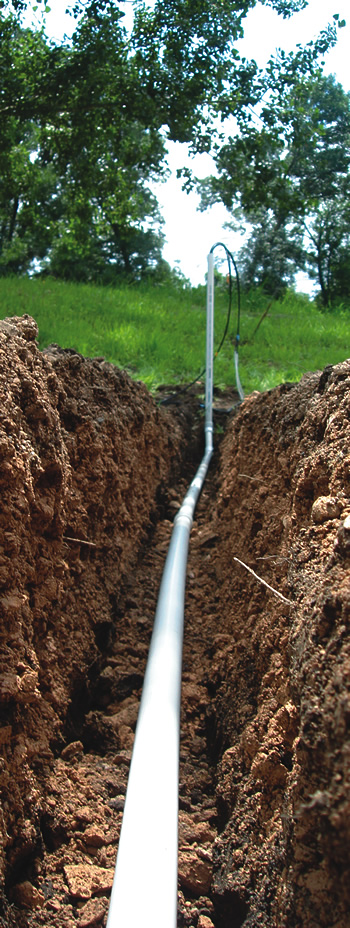
The lysimeters were buried at a depth of 36 inches and placed under negative pressure to allow for collection of contact water that infiltrated into the subsoils.
The MPCA requested that contact water be analyzed for 18 constituents, including pH, nitrate-nitrites, phosphorus, potassium, the standard EPA Part 503 metals panel, silver, copper, mercury, nickel, zinc and Total Kjeldhal Nitrogen (TKN). Sample collection took place after rainfall events of 0.5 inches or greater from April through December 2011 and May and June 2012. The remainder of the year the ground was frozen and infiltration of contact water into the subsoils was not possible.
Test results from all sample events were compared to the Minnesota Department of Health’s (MDH) Health Risk Limits (HRL) for drinking water. The drinking water standards are based on a filter water test whereas all of the water samples from the Arboretum composting site are readings from an unfiltered water sample. This was done to take the most conservative approach.
It was observed that the lysimeters located directly below the composting piles collected zero to trace amounts of contact water. This suggested that there is no vertical movement of contact water below the pile into the gravel pad and subsoils. The number of samples for each constituent varied based on the volume collected from the lysimeters. As a result, not all constituents were analyzed after each rain event. This also meant that the constituents to be sampled had to be prioritized with the agronomic constituents (NPK and TKN) having the highest priority, followed by metals and all other constituents as sample volumes allowed.
Sampling Results
Tables 2-7 provide the total number of samples for each constituent, the number of nondetection and the minimum, maximum and median test results. The final report published on the Minnesota Compost Council’s website contains a full write up of the project with all the data and lab sheets.
Table 2 shows the number of samples collected from the three control lysimeters. The majority of the tests from the native soils fell into the nondetect category. However, there were measurable results for four constituents — nitrogen (N), selenium, zinc, and Total Dissolved Solids (TDS). Three of the constituents were well below the limits, with TDS having no limit set by the MDH or the MPCA. The pH fell between 6 and 8 with the median being 7.5.
Table 3 provides the test results from the lysimeters up gradient of the compost berm for the commingled SSO and yard trimmings (YT). As can be seen, arsenic, cadmium, lead, mercury, molybdenum, Total Suspended Solids (TSS) and phenols were not detected. Nitrogen had median readings well below the MDH HRL limit, as were the readings for copper and zinc. For phosphorous, selenium, pH and COD, there were insufficient detectable readings to determine medians.
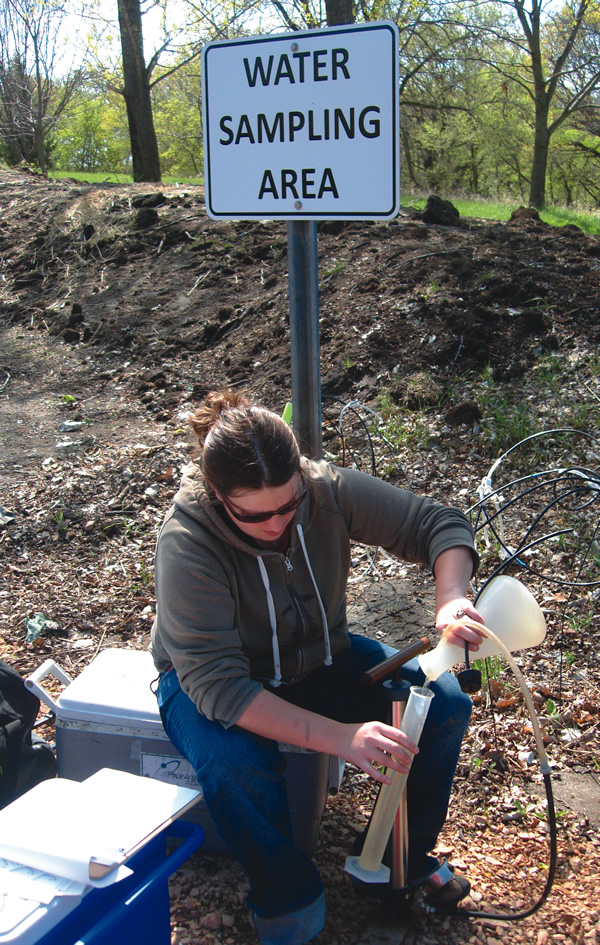
Water samples were analyzed for 18 constituents, including pH, nitrate-nitrites, phosphorus, potassium, the standard EPA Part 503 metals panel, silver, copper, mercury, nickel, zinc and TKN.
Table 4 gives the minimum, maximum and median results for samples of contact water collected from the YT only windrow up gradient of the compost berm. Potassium, lead, mercury, TSS and phenols were below detection limits.
Constituents tested that were detected and had MDH HRL included N, arsenic, cadmium, copper, nickel, selenium and zinc. Of those, all were found to have median levels below the HRL when sufficient samples were detectable. Six constituents had measurable test results, but do not have a corresponding MHD HRL. Those were phosphorus, molybdenum, TKN, pH, TDS and COD.
Table 5 presents the test results from contact water pulled from lysimeters down gradient of the compost berm for the commingled SSO/YT windrow. The table shows arsenic, cadmium, lead, mercury, molybdenum, nickel and phenols all fell below detection limit. Constituents detected but below the HRL included N, copper, selenium and zinc. Phosphorus, potassium, TKN, TDS and COD all were detected, but there are no HRLs for those constituents.
Table 6 provides test results from contact water pulled from lysimeters down gradient of the compost berm for the YT only windrow. For all constituents with an assigned HRL, all were found to have median levels below the HRL when sufficient samples were detectable. Copper, nickel, selenium and zinc had readings below the HRL.
The constituents with readings above detection limits, but with no corresponding HRL set by MDH were phosphorus, potassium, TKN, TDS and COD. There is only one test sample for COD because it was added late in the project and could not be tested more before the end of the grant. The COD reading was 376,000 ug/L.
Sheet flow sampling was added late in the project at the request of the MPCA, and only one sample was able to be collected prior to the end of the grant. The MPCA technical staff involved with the project oversaw the sampling method procedure and identified the constituents that would be sampled. Table 7 gives the minimum, maximum and median of the “sheet flow” samples taken during a 0.59 inch rain event on May 3, 2012.
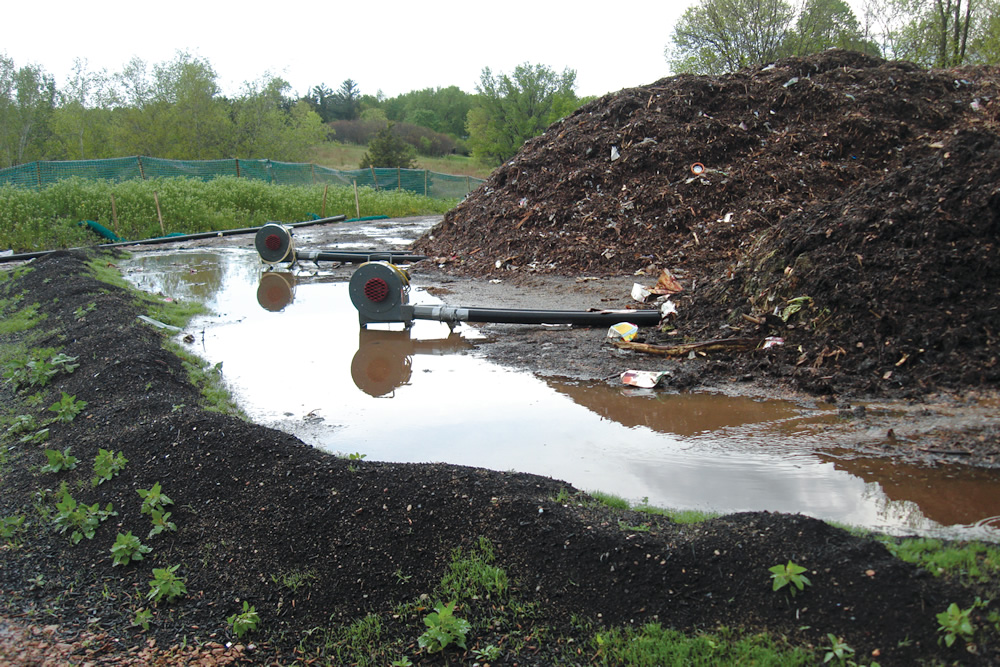
A compost berm (far left) was installed to measure how effective the berm was for treating contact water.
Overall Findings
The results of water quality monitoring studies by Carver County at the Minnesota Landscape Arboretum have indicated that static aerated windrow composting of source separated organics can be practiced with minimal impacts on ground and surface water quality. Although the available data is limited, the findings of this second project — along with that of the initial Carver County research conducted in 2007 — indicate levels of contaminates tested are low compared to Minnesota Department of Health Human Risk Limits.
Given the MPCA’s need for further evaluation, Carver County applied for and received a third grant in 2012 to continue the scientific evaluation of the potential impacts of contact water on the environment. The third project and its findings will be reported in Part III and IV of this article series in BioCycle.
Ginny Black, formerly an Organics Recycling Specialist with the Minnesota Pollution Control Agency, is Chair of the Minnesota Composting Council. She also is president of the Composting Council Research and Education Foundation. Marcus Zbinden works for Carver County as an Environmental Specialist and is Vice Chair of the Minnesota Composting Council and Chair of the Recycling Association of Minnesota.
